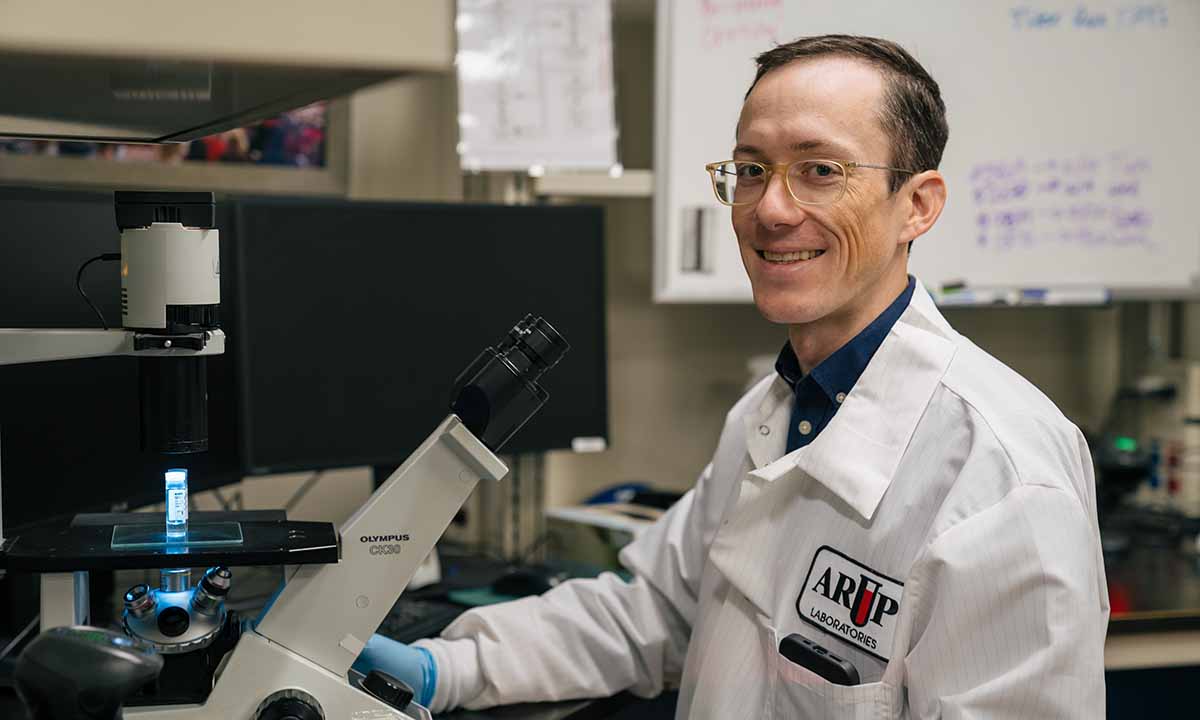
Benjamin Bradley, MD, PhD, is set to publish his first two virology articles on monkeypox testing protocols as ARUP Laboratories’ medical director of Virology and Molecular Infectious Diseases.
To his colleagues, Benjamin Bradley, MD, PhD, is always in the right place at the right time, with the right expertise.
In February 2020, Bradley was completing his residency at the University of Washington Medical Center’s department of Anatomic and Clinical Pathology when the nation’s first SARS-CoV-2-positive cases were confirmed in Seattle.
In the throes of an emerging public health crisis, Bradley and his colleagues at the University of Washington published the first case series of histopathology and ultrastructural findings of fatal COVID-19 infections in the United States.
“I'll never get a publication that cool again,” Bradley said. “Hopefully, there will be no other pandemics that cause that, but it was a really huge thing.”
In July 2021, Bradley was looking for an opportunity to make a difference in infectious disease diagnostics when he began his fellowship at ARUP Laboratories, and in August 2022, Bradley was appointed as medical director of Virology and Molecular Infectious Diseases at ARUP Laboratories amid another public health crisis: monkeypox.
With the lessons learned from the COVID-19 pandemic, Bradley saw a need to help other labs quickly scale up monkeypox testing. Within weeks, he had written his first virology manuscript as a medical director, with hopes of supporting other reference labs in their understanding of monkeypox virus.
“The first thing he did was start looking at our data on the number of times we were culturing,” said Marc Couturier, PhD, ARUP medical director of Emerging Public Health Crises, Parasitology/Fecal Testing, and Infectious Disease Antigen Testing. “He put together this nice data set on the number of times the virus grew culture, the time it took to grow, and what it looked like in the cell cultures, so people in the field could have a heads up of, ’Hey, this is our experience, and this is what you can expect if it happens in your lab.’”
The preprint of Bradley’s first article, “Characterization of the Cytopathic Effect of Monkeypox Virus Isolated from Clinical Specimens and Differentiation from Common Viral Exanthems,” provides information never previously documented for clinical samples of monkeypox virus.
His findings offer guidelines for excluding common viruses that may present with skin lesions similar to those seen with monkeypox, such as herpes simplex virus (HSV) or varicella-zoster virus (VZV). Additionally, Bradley’s work demonstrates the recovery of live viruses from specimens with low viral loads, emphasizing the highly infectious nature of the monkeypox virus.
The preprint of his second article, “Clinical Performance and Trends During the First Two Months of Monkeypox Virus PCR Testing at Two United States Reference Labs,” further expands these guidelines. By examining cycle threshold values, epidemiologic characteristics, and specimen collection practices, Bradley’s findings offer a collection of data necessary for identifying variants and improving testing practices.
“Because of the volume that we are able to test at ARUP, we can find trends and patterns that might be more difficult for smaller labs who are, say, running 20 tests a week as opposed to 200 tests a week,” Bradley said. “And because we have this volume, we can see these patterns earlier in an outbreak, and based on those patterns and trends, we can find guidelines to give these other labs.”
Bradley hopes his research will offer clinical laboratorians a base of solutions to current and potential issues in test performance, not just for monkeypox, but for all developing health crises.
“I think one of my main areas [of interest] will be to continue moving forward to address these emerging public health issues,” Bradley said. He wants to ensure ARUP has both nimble testing and sufficient capacity to respond quickly and effectively when health crises arise.
Both of Dr. Bradley’s manuscripts have been accepted for publication and will be available in the Journal of Clinical Microbiology next month.
Camryn Fife, camryn.fife@aruplab.com
















